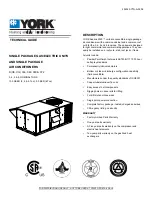
Installation Notes
Tools Needed for Installation
Screw Drivers:
Both Phillips and flat head
Power Drill:
1/8 inch diameter drill bit
Pencil
Measuring Tape
Scissors
Carpenters Level
Your Room Air Conditioner is designed for easy
installation in a single or double-hung window. This
unit is
NOT
designed for vertical (slider type)
windows and/or through-the-wall applications.
NOTE:
Save the shipping carton and packing
materials for future storage or transport of the unit.
Remove from carton, the plastic bag containing the
installation hardware kit necessary for the installation
of your air conditioner. Please check the contents of
hardware kit against the corresponding model check
list, prior to installation of the unit. See
Fig. 1
4
CAUTION
To avoid installation/operation difficulties,
read these instructions thoroughly.
Electric Shock Hazard
To avoid the possibility of personal
injury, disconnect power to the unit
before installing or servicing.
Energy-Saving Tips
Your Room Air Conditioner is designed to be
highly efficient in energy savings
.
Follow these recommendations for greater efficiency.
1. Select thermostat setting that suits your
comfort needs and leave thermostat at that
chosen setting.
2. The filter is very efficient in removing airborne
particles. Keep air filter clean. Normally, filter
should be cleaned every 2 weeks. More
frequent cleaning may be necessary depending
on indoor air quality.
3. Use drapes, curtains, or shades to keep
direct sunlight from heating room, but
DO NOT
obstruct the air conditioner. Allow air to circulate
around the unit without obstruction.
4. Start your air conditioner before outdoor air
becomes hot and uncomfortable. This avoids an
initial period of discomfort while unit is cooling
off the room.
5. When outdoor temperatures are cool enough,
use
HIGH
or
LOW FAN
only. This circulates
indoor air, providing some cooling comfort, and
utilizes less electricity than when operating on a
cooling setting.
Installation Hardware
3/4" Screws (7)
*3/8" Screws (4)
*Factory installed on
some models.
Safety Lock (1)
Side Curtain LH (1)
Adhesive
Foam Seal (1)
*“L” Shaped
mounting bracket
(1)
*Factory installed
on some models.
Fig. 1
Side Curtain RH (1)
Sash bracket (2)
Caractéristiques de télécommande
Affichage Électronique:
Affiche l’information suivante;
A: Icônes du Télécommande ‘En Marche’ et Mode.
B: Horloge et Minutrie
C: Réglage de la température
D: Réglage de Vitesse du ventilateur
Boutons De Commande:
1.
Commutateur de courant
2.
Mode
3.
Vitesse du ventilateur
4
. Économiseur d'Énergie
5.
Minutrie
6.
Utilisé pour augmenter
ou réduire
le température
par incréments de 10 et le minuterie en incréments de 0.5
hr jusqu’a 10 heures et incréments de 1 hr jusqu’a 24
heures.
7.
Annuler le programme “Minutrie en Marche” et/ou
“Minutrie Arrêt”.
8.
Serrure
empêche les arrangements de
télécommande d'être changé.
9.
Horloge: Appuyez sur le bouton pendant 3 secondes
pour régler l'horloge. Appuyer sur la flèche
ou
pour
ajuster l'horloge en les incréments de 1 minute, ou
continuez à maintenir la flèche pour ajuster le temps en
incréments de 10 minutes.
10.
Mode de Sommeil.
11.
Lumière d’affichage électronique (allumez/arrêtez)
12.
Reconstituez tous les arrangements de
télécommande au réglages par défaut.
Deux piles alcalines « AAA » sont requises pour le
fonctionnement de la télécommande (incluses).
Les piles devraient être remplacées quand :
a) Aucun signal sonore (bip) n’est entendu durant la
programmation de l’unité principale.
b) L’unité principale ne répond pas à un signal émis par la
télécommande.
Remplacement des piles :
1.Glisser le couvercle du compartiment des piles à
l’arrière de la télécommande dans le sens de la
flèche. Tirer délicatement jusqu’à ce que le
couvercle se sépare complètement de l’unité.
2.Insérer deux (2) piles (AAA) en observant la polarité
indiquée dans le compartiment des piles (+/-).
3.Réinstaller le couvercle.
4.Si la télécommande ne sera pas utilisée pour des
périodes prolongées (vacances, etc.), les piles
devraient être retirées de la télécommande.
La télécommande fonctionnera en dedans d’une distance
de 8 mètres (26 pi.) du récepteur situé à l’intérieur de
l’unité principale. Toute obstruction entre le récepteur et la
télécommande pourrait causer une interférence au signal,
ce qui limiterait la capacité de programmation de l’unité
principale.
MODE
©
1
2
3
4
5
6
7
8
9
10
11
A
B
C
D
Affichage
Électronique
12
19






























